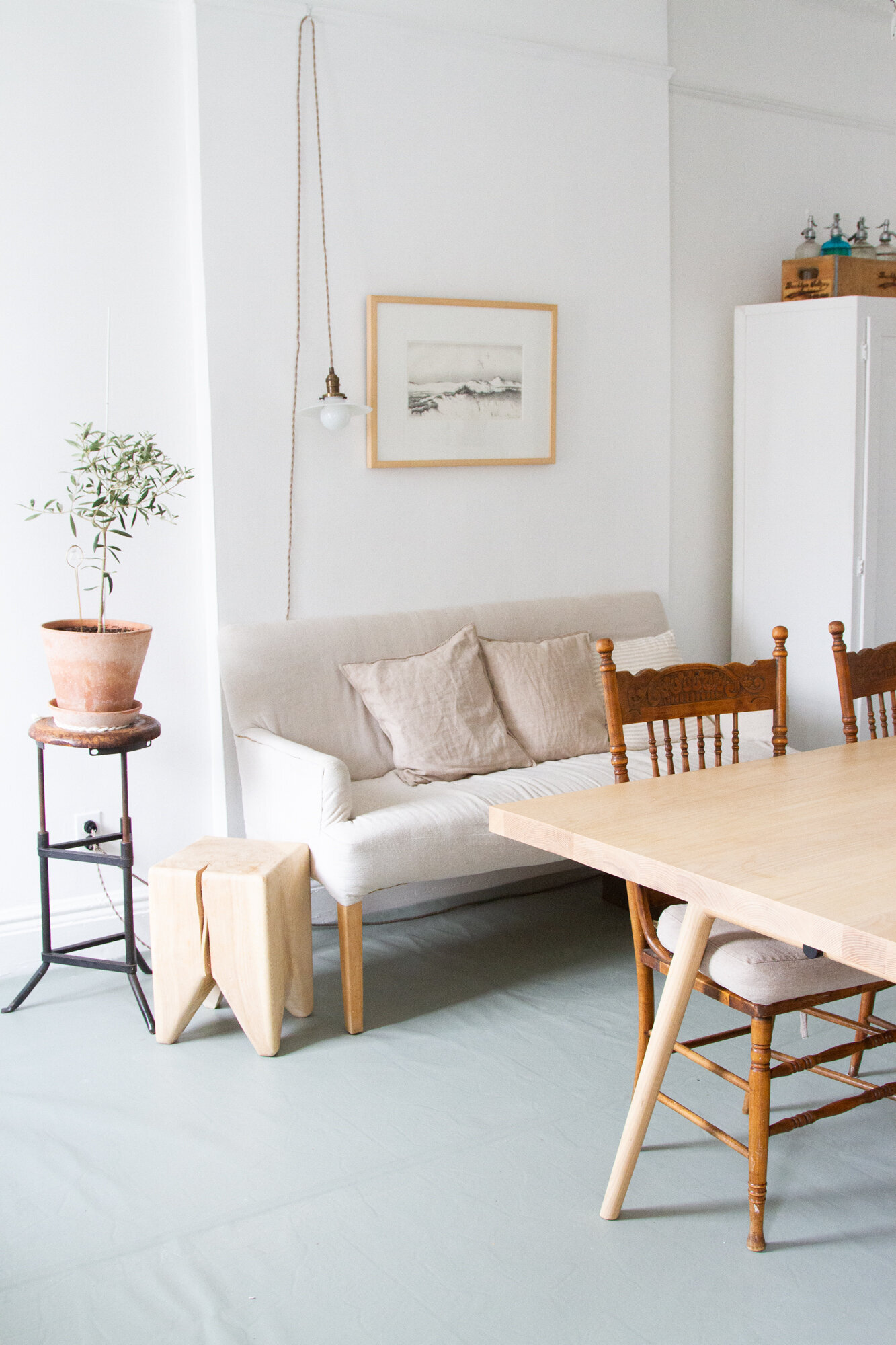
We have a wall-to-wall painted canvas floorcloth in our dining slash living room. I painted it myself last fall and while I’d love to take credit for the idea, painted canvas floorcloths predate me by a few centuries. I needed a simple, hardwearing, and ultimately temporary solution for covering a less-than-great floor in a rental apartment and floorcloths fit the bill in terms of cost, aesthetics, and quirky historical precedent. Also called oilcloths, painted canvas floorcloths would have been found covering wood floors in the stately homes of early US-ians like Founding Fathers themselves, George Washington and John Adams. Early floorcloths were often painted to mimic more precious carpet or tile patterns and modern replicas often go this route as well. No surprise to anyone, I decided to keep mine plain and simple.
The particulars of this project are many and I’m not sure how applicable they might be to the average reader, but I’ve done my best to answer the frequently asked questions about making and living with a painted canvas floorcloth! If there’s anything I’ve missed, feel free to ask in the comments. Additional resources below!
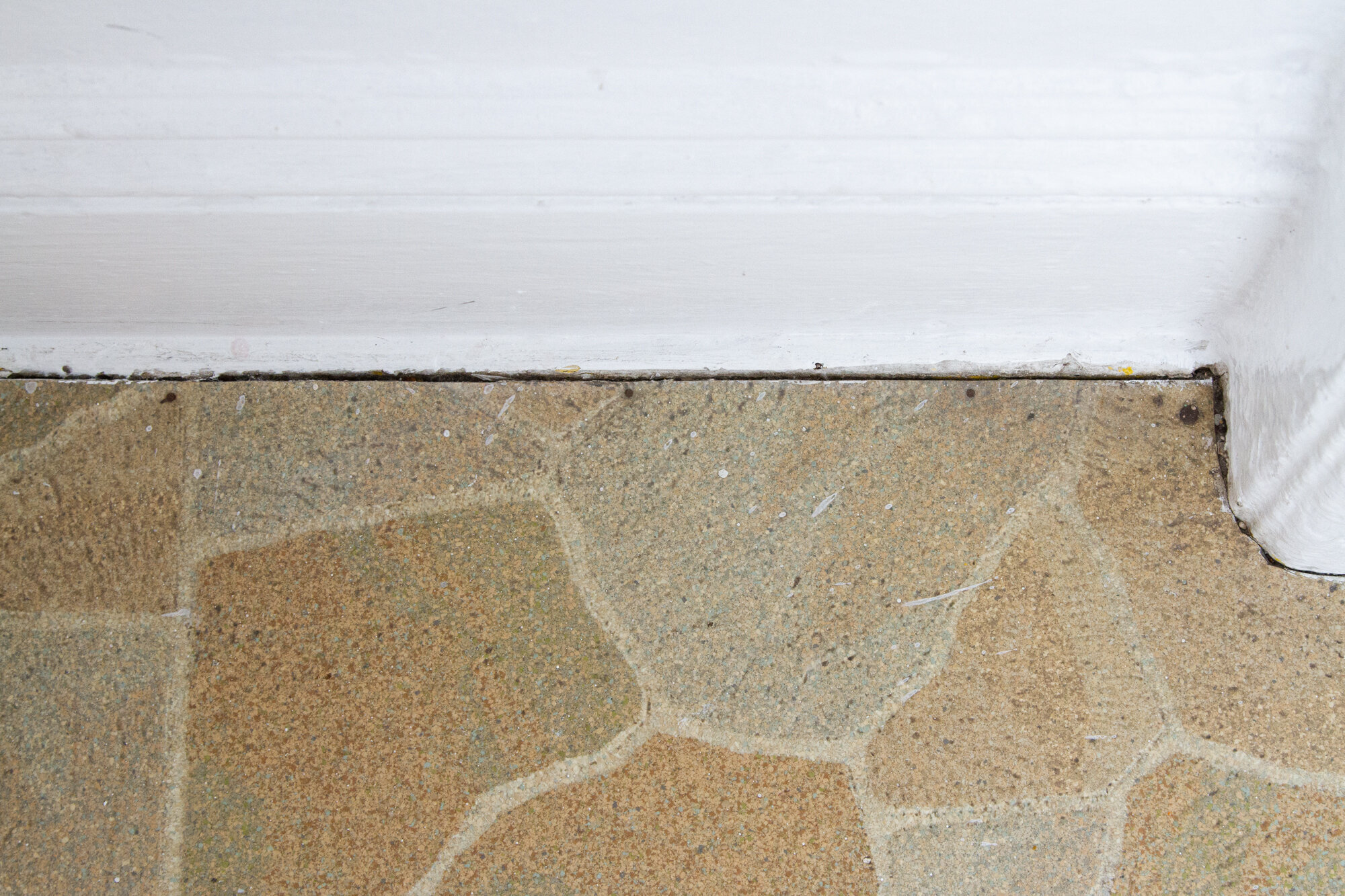
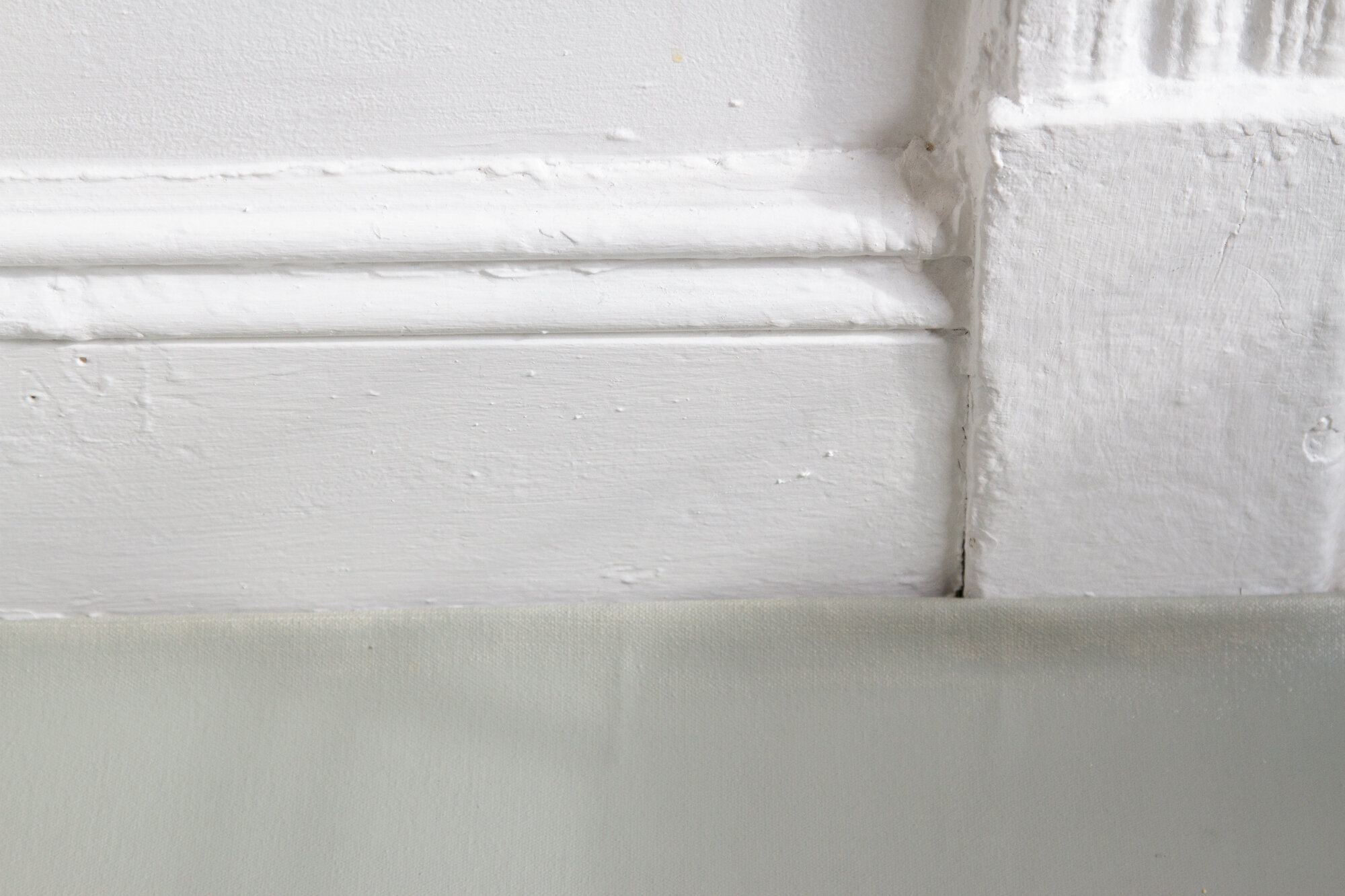
Why a painted canvas floorcloth?
Why did you want to cover your floor?
The existing floor in this room is vinyl, or possibly linoleum, and while lots of folks, including me, use these terms interchangeably, the materials are actually very different! Linoleum has been around since the mid-1800s and is made of naturally occurring materials like wood flour, limestone, jute and linseed oil. It’s generally considered to be eco-friendly and it’s seeing something of a renaissance for folks looking to lighten the environmental impact of their home renovations. Vinyl flooring on the other hand dates from around the 1950s and is made of synthetic materials. This early vinyl often contains asbestos and should generally not be removed or disturbed without proper abatement.
Beyond the possible ick factor of asbestos in our old floors, I really didn’t love the floor in our main living/dining room. It’s embossed with a faux stone pattern that’s not to my personal liking aesthetically and doesn’t feel particularly nice underfoot either. More crucially, in this room and and in our kitchen, the flooring was put over an existing floor (or subfloor—I don’t know) and nailed into place, likely sometime around the middle of the last century. All things considered, the floor is in overall fine condition, but there are cracks and crevices along the outer edge. Worst of all, it doesn’t extend underneath the baseboard which means that around the whole perimeter of the room there’s a gap which would be better called a trap. It’s very hard to keep clean and an especially gross thing to live with when sharing a home with a crawling baby who likes nothing more than to fondle dropped crumbs and floor cracks with very tiny fingers. Taking the canvas floorcloth all the way to the very edges of the room was the best solution I could think of for covering that gap and it’s been working beautifully.
Why didn’t you just pull up the existing floor and replace it?
The shortest answer is that’s a big project! We don’t own this apartment so a project of that magnitude and investment is really not ours to take on. (It’s one thing to paint a door, it’s quite another to rip up a floor and install a new one!) Before I tackled this project, I chatted with my landlords about covering the floor and got their go-ahead as long as I wasn’t planning to glue anything or affix the covering with nails.
Why didn’t you cover the floor with prettier vinyl flooring—there are so many patterns and colors out there!
There are lots of vinyl options out there, from peel-and-stick vinyl tiles to fancier vinyl floorcloths, but while it’s a very common and affordable building material, vinyl is really not so great for our bodies or for the environment. I really wanted to try something different, especially because part of the reason I wanted to cover the existing floor was not loving the look or feel of vinyl in the first place. I’ve also wanted to make one of these canvas floorcloths for a very long time. I never thought it would be a wall-to-wall behemoth, but I was excited to see what I could make work in a tricky room.
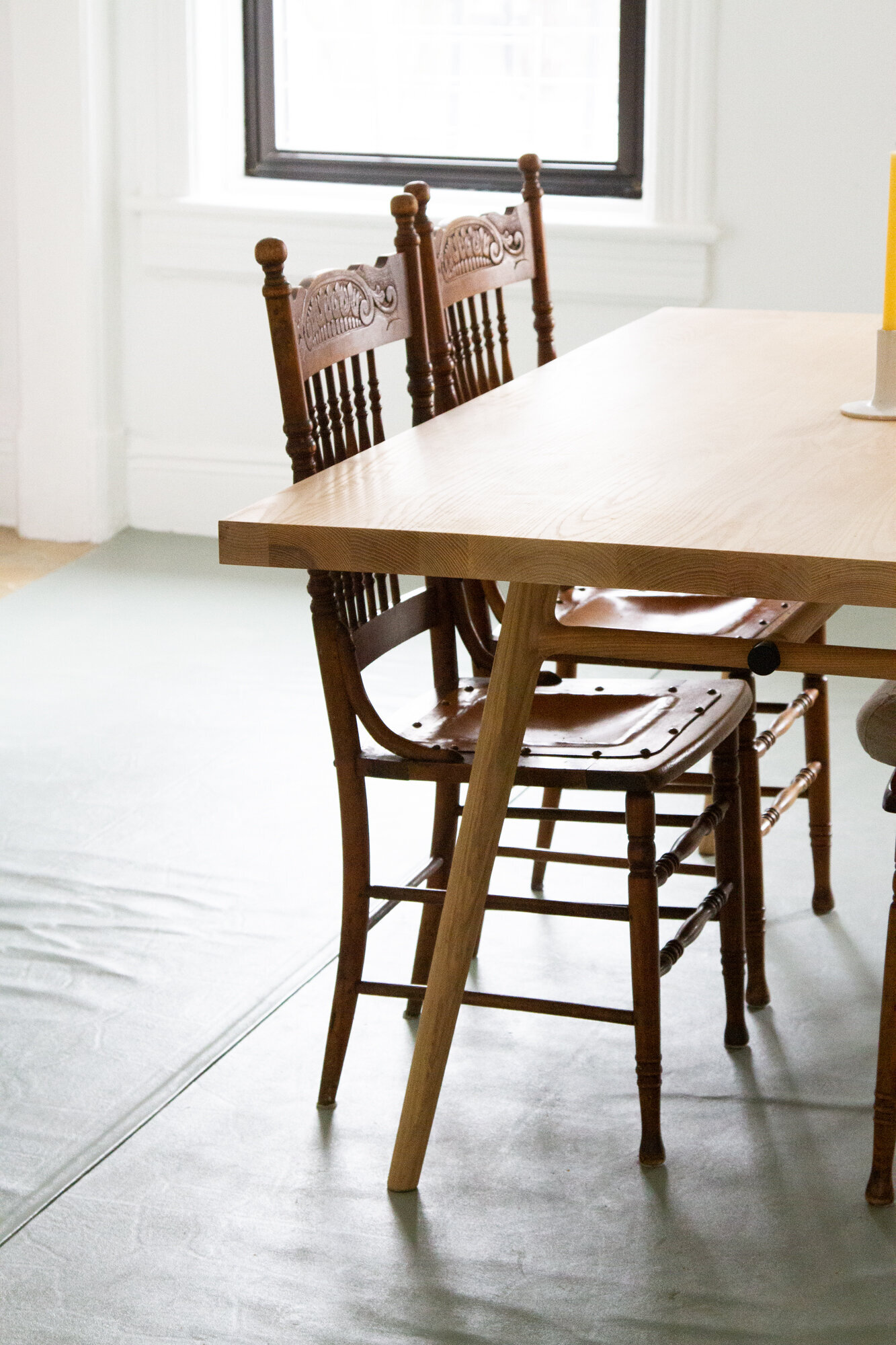
How do you make a painted canvas floorcloth?
What materials did you use?
+ Primed canvas: I used the #8 Primed Floor Cloth Canvas from Canvas Etc. The folks there were nice enough to supply the canvas for this project to me and I can’t recommend their canvas enough. The triple-primed canvas significantly cut down on the prep and painting time and it also felt like pretty good insurance against user error. It was a comfort to know the first three coats of paint were already there!
+ Heavy-duty scissors: I borrowed these shears from a neighbor through the Buy Nothing Project and I was so grateful for them! This canvas is thick and having heavy-duty scissors made cutting it easy.
+ Needle and thread (and a sewing machine): Primed canvas is heavy and needs an industrial machine to get through it. I paid a local awning shop to sew two seams in their workshop in Gowanus. It took a bit of calling around to find a shop willing to take on such a big project (and original quotes for two seams were upwards of $600) but I eventually found a spot with a more affordable price point. Because I was making such a large covering I decided to fold my edges under rather than hem them. For me, the folded edges are the perfect folly for the gap that exists between the floor beneath and the baseboard and I deliberately folded the edges so that they extend 1/4″ inch up the trim and fully cover the gap. Folding the edges once the floorcloth was in place was a simple way to achieve a close fit around a wonky room.
+ Paint: I used Farrow & Ball Pigeon in an Estate Eggshell finish to cover the floor. There are about three coats and I have about 8 ounces of extra paint remaining should I need to make touch-ups. Honestly the whole thing could probably use another coat or two, but I wanted to see how it wore and what it was like to live with before investing in another can of paint (and another afternoon of painting).
+ Thresholds/Saddles: One of the trickier puzzles to solve for a wall-to-wall floorcloth was how to deal with the entryways into the room. The main door of our apartment opens into this room and so the floorcloth needed to be kept in place and protected from a door that opens many times a day. I decided to gently remove the existing metal saddle/threshold, lay the floor cloth underneath it and and replace the original nails. This way I wasn’t disturbing the original flooring, I can easily remove the floorcloth when we move out, and the floorcloth stays in place when the door opens and closes. I still haven’t settled on the perfect saddle for connecting the floorcloth in the double doorway that leads from the dining room to our bedroom, but for now it’s laying flat and hasn’t caused us any issues beyond looking undone. I’ll give an update when I settle on a solution!
How much did it cost? This floor cloth covers a ~209 square-foot room. It took about $150 worth of primed canvas to cover the room. I paid an awning shop $200 to sew two giant seams on their industrial machines. And I used one 4-liter can of Farrow & Ball paint to cover it. The final price, no doubt, depends entirely on the size of the cloth being made, access to an industrial sewing machine, and the kind of paint used!
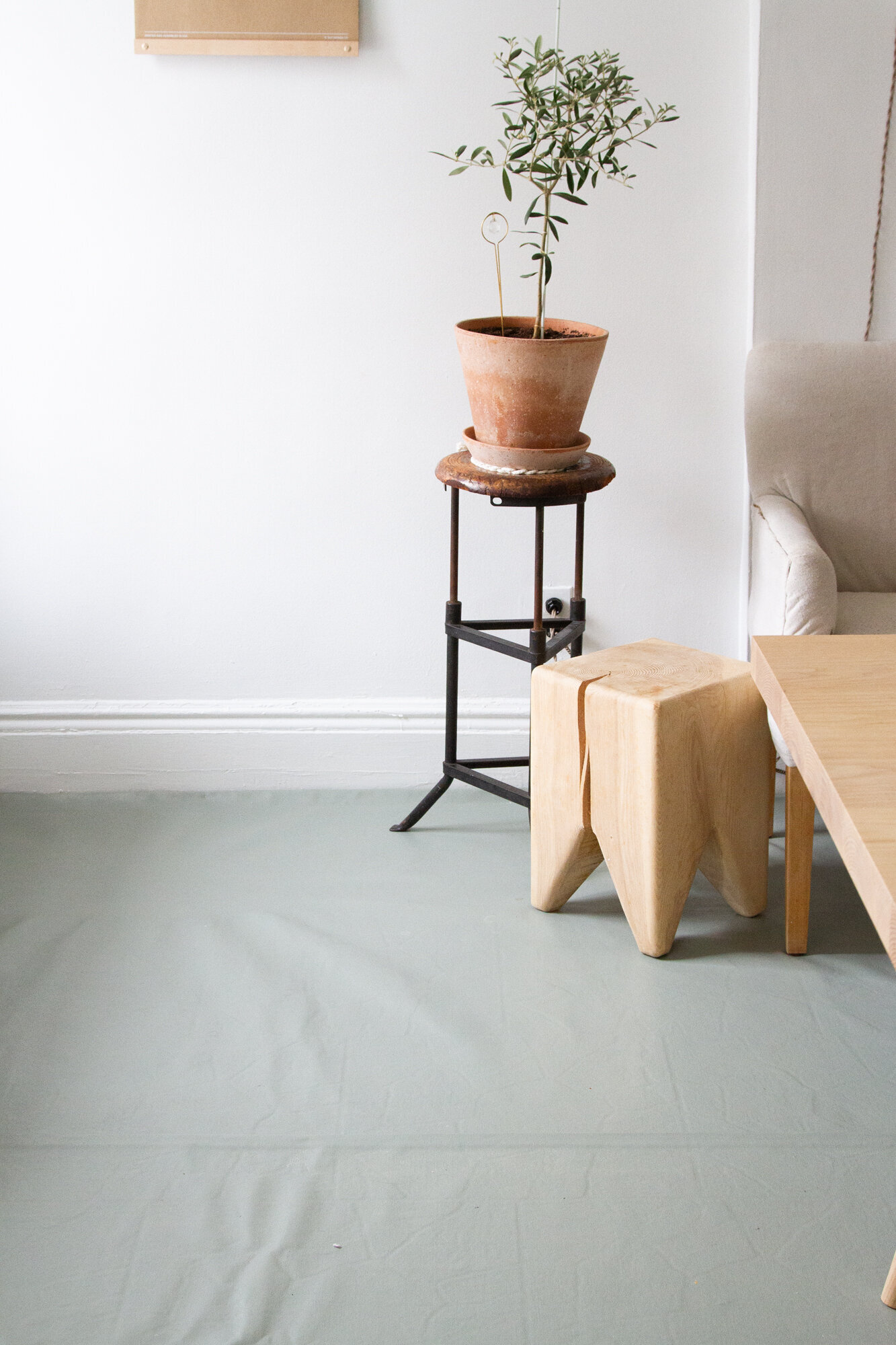
What’s it like to live with?
For us, the painted canvas floorcloth is a huge (huge) improvement over the vinyl flooring. It’s visually much calmer, it feels far better underfoot, and it solves the problem of the dirt trap between the flooring and the wall. Generally, it’s taken a kind of grody room in a rental and turned it into a spot that feels better and brighter and more like a place we want to spend time in.
Is it weird? Does it feel like you’re camping? Why did you put a plastic tarp under your beautiful table…etc.? I love this thing. It’s so much better than the vinyl alone and I have no regrets. I grew up in a very old house where at least half the wooden floors were painted, so painted floors are a familiar and normal thing for me and this doesn’t feel very different from that!
Do I see wrinkles? You do! Like me, this floorcloth is not perfect. There are some ripples, especially where I (regretfully) folded the length of fabric to transport it home from the awning shop (though many have relaxed over time). Like lots of things, they show up differently in photographs than they do when you actually live with them! We hardly notice them!
Does the floorcloth slip? Not a bit. Painted canvas is quite heavy! Mostly for cost reasons we didn’t cut a wall-to-wall rug pad to go under this even though that’s something we could have done. Still, there’s no slippage at all. If you were to tackle a smaller-scale floorcloth that didn’t stretch wall-to-wall, there might be more chance of sliding, but a simple rug pad would solve that!
Can you clean it? Yes! We vacuum and sweep our floorcloth just the way we did the vinyl underneath it. We generally spot clean the floor when something spills and use an all-purpose spray and a slightly scrubby sponge or this mop for wet cleaning. I plan to eventually make a second floorcloth for the kitchen, but there are a few more pipes and radiators to contend with in there so I’m steeling my nerves and refilling my stores of energy.
Is it waterproof? Mostly! The three coats of primer and three coats of paint make a pretty solid seal on the fabric and in the past few months it has certainly seen its share of spills. That said, I really wanted this to be a relatively low-stakes investment in terms of labor and materials and so I didn’t use any kind of sealant beyond the paint. Three months in, the cloth is holding up beautifully and washes up easily, but a sealant could be something I decide to add in the future for extra protection against spills or mold &c!
Can you move it? Eventually, yes! Beyond the nailed-in-place threshold, I used two small tacks to hold down corners of the cloth that I snipped to fit around and behind our steam radiator. I’m hopeful that this holds up well enough that when we eventually move I can cutting it down to size and take it with us to use as an area rug.
Resources:
Canvas Etc. provided the pre-primed canvas for this project and they have a wealth of knowledge and the canvas should you be interested in tackling one yourself!
This Old House has a great video on making canvas floorcloths in case you’re not convinced this is something that other people actually do!
Garden & Gun ran a beautiful story on far more intricate floorcloths, should pattern and color excite you!
Remodelista has a tutorial from my old colleague Justine Hand with step-by-step instructions for making a striped floorcloth runner in case you need more visuals or a project with a less overwhelming scale.
//
This post includes several affiliate links. Reading My Tea Leaves might earn a small commission on the goods purchased through those links.

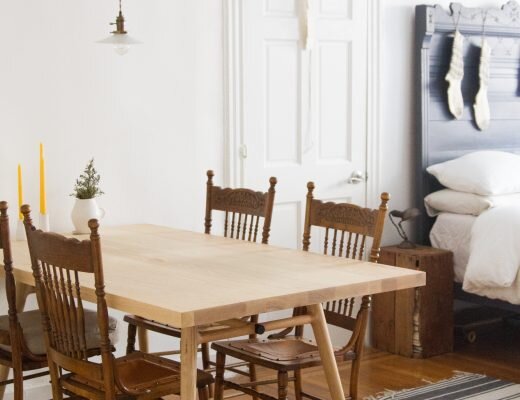
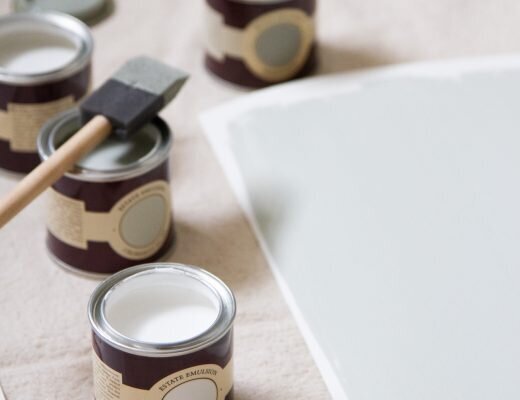
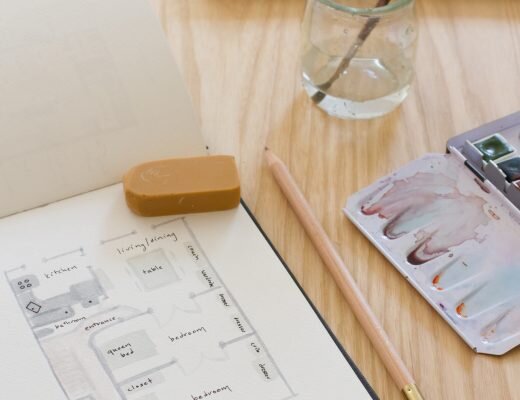
38 Comments
I love learning about your creative solutions! Whether I would make the same choices or not, it really helps my brain to stretch to find ways to improve my own home that really are right for me, or at least, a low-impact experiment. It’s so great to get inspired by history (oiled canvas!) to contend with other historical choices (1950s synthetic things!). “Newer” ideas have merit, but aren’t the only way forward. Very cool to learn about your process here.
I had never heard of this but think it’s so cool. LOL at this line – “in case you’re not convinced this is something that other people actually do!”
What a lovely solution, I admire your resourcefulness!
I love the floorcloth. Question: Is it less slippery than a wooden floor? We need to put a runner down our beautiful fir stairs (that we paid a lot of $$. to have stripped of the turd brown paint that a previous owner had covered them with). We have an aging dog, and we are aging as well. One of these days one of us is going to slip. Just wondering if a painted floor cloth is a potential solution here….
Ah, I’d actually say that it’s slightly more slippery than a wooden floor, but less slippery than a painted wooden floor. I know folks with dogs have floorcloths, but I don’t have any insight on whether they’d be terribly good for an aging pup!
Sherry and John over at Young House Love installed a lovely stair runner in their new house for their aging chihuahua, Burger. It looks like a generally straightforward project! Linked below.
Great work, Erin! What a big project, well done! My mother-in-law paints small floor cloths often and has them peppered throughout her old farmhouse. Hers are 2×3 feet, generally, and she paints them intricately with roosters and chickens and other farm life (not my taste but worthy of admiration without a doubt!). At that size, they do slip about – though not as much as a wool or cotton rug would – and in any case, if she was fussed she could certainly use a rug pad. For her, it is a real labour of love and a way to display her paintings in a new, wall-less, way. I love the way a floorcloth project can be so different and meet so many needs – as a practical way to create a safer and cleaner home environment, and/or to scratch the creative itch.
This was interesting, thank you. I am curious though why your landlord has never updated this apartment. Do the rest of the units in this building have the old floors/bathroom/stoves, etc? I live in brooklyn as well so it’s fascinating to me that nothing has been updated in the last 70 years! Was it the same tenant living there all this time? I need backstory please!
I don’t much about the tenant history is this building, but the family who loved here before us were here for about six years and they live in the garden apartment now!
this is genius, thank you for taking it on and sharing!
ah, thanks! so glad to!
YEAH, YOU DID. Good work, Erin. A beaut!
IT BRINGS ME SO MUCH JOY TO SEE YOU HERE! IN FLOORCLOTH FRIENDSHIP AND GRATITUDE, YOURS TRULY!
*DOES WAVING* XOXOXOXOXO
I love the way it brightens up the room. Such a lovely combination of colors and a very practical solution! I grew up touring historic houses all over the country (sometimes happily, sometimes not, depending on my age at the time ) with my family, and so many of them had floor cloths. Definitely a long-standing tradition that’s worth returning to! And much less expensive that basically any other solution out there
Sometimes happily, sometimes not! SAME, SAME! Thank you!
Thank You for the ‘recipe’ for something so so clever, Especially with little ones!! Not putting a hem in was Brilliant idea !!! I have always been keen to try doing one on smaller floor, no hem would solve SO many issues. That EXACT measuring is just toooo nerve racking! So now it would be easy peasy to do! For a small cloth I could even do the canvas preparing myself!!!
Thank You Thank You Thank You!
Ps. Love your colour, perfect fit for you space.
It really looks great! And who knows, but I’d hasten to bet you’ll fuel a new trend! I know it’s not your reason, but I hope you get credit for revitalizing an old art, modernizing it along the way (monochroming whilst minimalizing: all the right boxes!) Thank you for generously sharing so many good things. I may have to try this myself!
Wow this looks awesome! Thanks so much for sharing! You have probably already thought of this but one idea for the threshold if it starts to come up would be the 3m Velcro strips. As a renter, I’ve found an odd amount of uses for them!
Thank you! And yes! I originally thought I might use those! The canvas is actually heavy enough that it doesn’t curl up or move around; in the spot between the bedrooms it’s not folded because it was cut closer to size so if anything it really needs something to just create a more finished edge!
Oh that makes sense, I see what you mean now! Way to go taking on this big project and coming out the other end with such a beautiful result. I’m tucking this away as an idea for hall runner.
This is really amazing! I was pretty excited to see this project and here your backstory of doing this! Back in the mid 90’s a transplanted Brit Debbie Travis had a Canadian TV show called The Painted House in the pre-HGTV days. I remember her doing floor cloths like this for kitchens (smaller and more rug like but she spoke to this being a common floor covering in days gone by). She did seal them with urethane (to make them scrubbable) but it was the same idea! I thought it was the coolest thing ever – DIY a kitchen floor! Years later I found a canvas floor cloth laid almost wall to wall in a decrepit 1888 house I bought in a fit of madness/lack of funds (under many layers or flooring types and newspapers). Based on the newspapers it was done 1920-1930’s.. It was deep red with hand painted flowers in a garland around the room (quite horrific actually but I appreciated the effort). Total DIY job. But it had held up remarkably despite the layers of linoleum and vinyl on top almost a century passing by. It feels very appropriate for your old brownstone home!
OMG The Painted House. I haven’t heard that referenced for decades. How many pairs of overalls do you think she had??? How did all that faux marbling stand up??? whitewash everything! 😉
https://www.younghouselove.com/diy-sisal-stair-runner-install/
NYC landlords get away with so much. If you were ever interested, there are asbestos testing kits for very cheap. If the vinyl floor is problematic, the landlord might just have to update the floor. Might be worth testing!
This is amazing! We have nice dark wood bamboo floors that we paid to put in our house 10 years ago when we bought it, but three kids later, they are all scratched up, particularly under the table where little bits of dirt and food get stuck on the chair bottoms. I was thinking of buy a rug, but my kids spill so much, I didn’t want to risk it. This is a perfect solution. It’s also the perfect solution for our kitchen, with its ancient vinyl floor that is peeling up. We plan a kitchen overhaul in a few years when we have saved up enough money and our kids are old enough not to destroy it, so for now, we are looking for temporary solutions. I had never heard of this, but I now have a plan for warmer weather.
I love it! As the child of parents who insisted that family vacations were to be history lessons, I spent my formative years staring at many oil floorcloths. I’m not sure if I’m ready to exercise my demons (for the record, Shakertown in the 1970s was not a place for children!) and sign up for my own, but I love seeing yours in a more modern setting. Thanks for sharing!
I love this so much. I love learning about floorcloths and they’re history, I think yours looks beautiful, and I love that I now have this idea in my back pocket (fellow Brooklyn renter, here!) should I ever need it. Thank you so much for sharing this post.
Thank you for this tutorial. Do you think this would work on top of carpet? I, very unfortunately, have a tiny carpeted dining room in my rented apartment, a toddler, and a preschooler. I made a tiny painted floor cloth years ago for under the table, but it was a bunched mess as I pushed the chairs in an out from the table. But room size, tacked down….? I never thought of that. Your solution for the entryways makes a lot of sense. (Also I am now making beeswax candles because of your last tutorial! Your blog is da best).
Oh man, thanks! I really can’t say how it might fare on carpet—I think it would have to be very very low pile to work!
Erin this is so cool and inspiring. I feel like it just breathes so much life into a room. Just wondering- if you were to use a sealant in the future what would you use?
This looks amazing! I have a question about the babies on floor cloths. I really want to make a small floor cloth for an art corner in my baby’s room, but he is not past the licking things age yet – I don’t know how long that will last. Is the paint you got ok for that? What should I look for in paint?
I feel a whole lot better about babies licking this paint than the vinyl it’s covering! I used Farrow & Ball in part because of their commitment to non-toxic paint. Here’s more about that: https://www.farrow-ball.com/en-us/our-story/eco-friendly-paint
This type of floor covering actually goes back even farther, into at least the renaissance. I’ve made several for various reasons in the past and had some lovely instructors to guide me. I particularly love them for places which may get damp, because the paint helps ward off mildew. Though, you can treat them with linseed oil for more water resistance. You can also spray with borax solution to ward off bugs and reduce fire risks should you choose to take yours camping or eat by candles on them! (You can and should research on your own and make your own decisions. )
All true!
I remember in the 80s in Australia there was a fad for making them; you were supposed to paint the back with a sort of liquid rubber to stop it slipping (and I think you could also use the rubber to stick down the turned edges, to save on sewing). The rubber did dry, in case you’re interested!
I bought a tin, but it’s still sitting somewhere…
Hi! First time, long time. I’m wondering how you are feeling about the floor cloth almost 2 years in? Any new tips or would-do-differentlys? In my kitchen, I have a similar scary edge crevice plus questionable vinyl material and pattern floor situation.
Love it so much! Grateful everyday I made the leap. I would say I wish I had painted a slightly thicker layer of paint to get really good coverage. I only had a gallon for this pretty big room and it covered two coats—I wish I had done three and might do a refresh one of these days! Otherwise it’s been so great!
Comments are moderated.